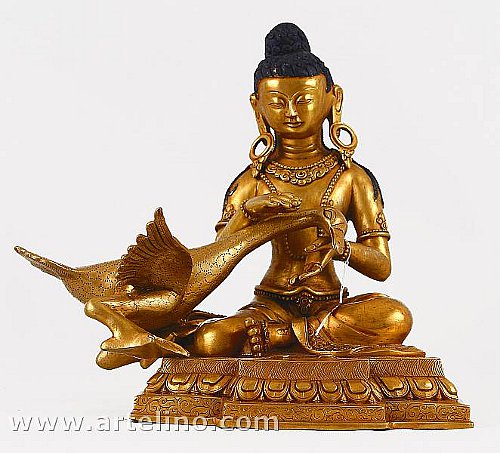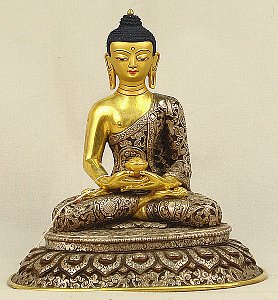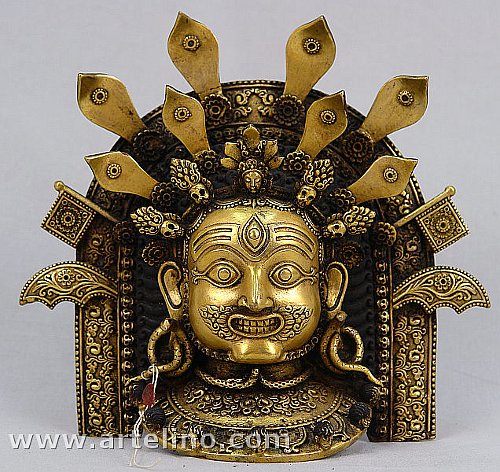| < Prev | Next > |
|---|
 All major world religions have developed over many centuries into different denominations, directions and sects. Buddhism does not make an exception. There are basically three types of Buddhism - Hinayana, Mahayana and Vajrayana. However, in contrast to Christianity or Islam, the followers of these different types of Buddhism have - to my knowledge - never fought war against each other.
All major world religions have developed over many centuries into different denominations, directions and sects. Buddhism does not make an exception. There are basically three types of Buddhism - Hinayana, Mahayana and Vajrayana. However, in contrast to Christianity or Islam, the followers of these different types of Buddhism have - to my knowledge - never fought war against each other.
This article explains the difference between these types of Buddhism and why things developed this way.
Shakyamuni Buddha - the Founder of Buddhism
Buddhism was founded by Gautama Siddhartha, an Indian prince who lived roughly from 563 to 483 BC. Gautama Siddhartha grew up with Hinduism, from which he took the belief in the cycle of rebirths. But the central issue of his teachings was human suffering.
One day the young prince had left the walls of his father's luxurious palace, and saw death, illness and aging. He realized that the world was not all pleasures but that there was suffering. At the age of 29 Gautama Siddhartha left the palace and his wife and young child and became a wandering monk. After 6 years he finally found the reasons for suffering and the way how to end it. This moment is called the enlightenment, and Gautama Siddhartha became the Shakyamuni Buddha.
Hinayana Buddhism

Shakyamuni Buddha spent the rest of his life teaching in Northern India. When he was about 80 years old he died of food poisoning, a frequent cause of death in those days.
The essentials of Buddha's teachings are the Four Noble Truths, the Eightfold Path, the concept of Karma and Nirvana. The Four Noble Truths are just an analysis, saying that there is suffering in the world, and that it can be overcome. The end of suffering is achieved by reaching Nirvana, which is identical with the ultimate enlightenment and which ends the cycle of rebirths. The Eightfold Path is the moral guideline that takes individuals in the right direction how to achieve Nirvana.
Karma means that all results come out of one's own actions. And thus each individual is responsible for himself. The concept of early Buddhism does not know a god or saints that you can ask for help. But by leading a good and moral life one will reach a better state in one's next life (reincarnation, the concept of rebirths) until the point when one reaches Nirvana, the final bliss. It is said that the historical Buddha himself had 500 rebirths until he finally reached Nirvana.

Hinayana Buddhism spread first in India where it disappeared later completely, forced back by Islam invaders and by Hinduism. Today the early form of Buddhism is still practiced in Sri Lanka and Southeast Asia (Laos, Cambodia, Myanmar, Thailand, Vietnam).
Mahayana Buddhism
 By its very nature Hinayana was a somewhat "elite" religion, more a philosophy than a religion. The individual was fully responsible for his own destiny. The whole concept is rather abstract.
By its very nature Hinayana was a somewhat "elite" religion, more a philosophy than a religion. The individual was fully responsible for his own destiny. The whole concept is rather abstract.
Buddha did not want any veneration of his person. During the first centuries of Buddhism images of the Buddha were unknown. Symbols were used instead.
The strong emphasis of meditation to achieve enlightenment (Nirvana) may have been appropriate for a monk. But imagine this for a common man, a farmer who had to work hard in his fields from dusk to dawn! The intellectual nature of the early form of Buddhism made it inapt as a mass movement.
As a consequence a whole league of little helpers were introduced to make the access to Nirvana easier. These little helpers are called Bodhisattvas.
Bodhisattva are benign and helpful beings who have already reached Buddhahood (enlightenment) but who refuse to go to nirvana as long as there are still beings in this world who have not yet attained this state. They are there to help others with their compassion.
With the concept of Bodhisattvas real images as palpable objects of veneration were introduced. Worshippers could now pray to images of the Buddha and a whole league of Bodhisattvas. An image is worth a thousand words, as the saying goes.
Mahayana Buddhism spread mainly to the North, to Nepal, China, Mongolia and Japan. The development of Mahayana began about 100 AC. The term Mahayana means "large vehicle". It was meant to indicate that it was apt for many, whereas Hinayana ("small vehicle") was only good for a few. Originally the word Hinayana was meant a bit derogatory.
Vajrayana Buddhism

It took two attempts to bring Buddhism to Tibet. The first one took place under King Songtsen Ganpo (ruled 630-649 AC) when he married a Nepalese and a Chinese princess. Both were active Buddhists and brought their religion to Tibet.
But only 200 years later the Great Tibetan Empire ended with the assassination of King Langdharma, and so ended the first era of Buddhism in Tibet. The original Bön religion, a shamanistic religion rich of demons, sorcerers, black magic and all kind of supernatural hocus-pokus kept the upper hand.
It took until the eleventh century for Buddhism to come back to Tibet in a second diffusion. It took place hand in hand with a clever integration of the old Bön religion. The demons of the old world were declared as subdued, but at the same time they were given a new role as protectors of Buddhism. A smart approach. First beat them, and then integrate them for your own purpose.
The result was Tibetan Buddhism or Vajrayana ("diamond vehicle") or Tantric Buddhism or Lamaism. These are all terms for more or less the same kind of Buddhism, a further development of Mahayana to this unique form of colorful and hard to understand religious culture of Buddhas, deities, saints, sages, gurus and sometimes historic figures mixed with mythological tales.
In the end this is the ground on which this unique, fascinating and yet so strange medieval Tibetan culture could develop.
Another strong aspect of Tibetan Buddhism is clericalism. In no other country the monasteries gained as much influence as in Tibet. Before the occupation of Tibet by the Chinese communists, an estimated 20% of the population may have lived as monks and nuns in cloisters.
Of course, Vajrajana is more than just the aspects of early Buddhism plus shamanistic plus clerical elements. But this is the mix that produced Tibetan culture as we have learned it today from the Tibetan refugees and their charismatic leader, the 14th Dalai Lama.
Buddhism in Western Countries

The flight of the Dalai Lama and thousands of Tibetans indirectly promoted a new movement of Buddhism among Westerners. Here the charismatic role of the 14th Dalai Lama played an important role in making Buddhism popular in Western countries. Western people among the intellectual elites are attracted by the non-violent and non-dogmatic character.
It is a development to a kind of life-style philosophy. Some regard Buddhism and its meditation practices as an efficient means to cope with stress situations in our Western societies. Buddhism and the Tibetan cause became especially popular in Hollywood circles. I have found the word 'Tibet Chic' (Lonely Planet travel guide, Tibet, by Bradley Mayhew and Michael Kohn). I think there is some truth in it.
In my view the personality of the 14th Dalai Lama has been paramount for the development of a Western Buddhist movement. One has to see how things will develop once His Holiness will not be among us any longer. Hopefully, this great man has many, many more years in good health ahead of him.
Dieter Wanczura, September, 2010.








